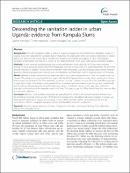| dc.description.abstract | While the sanitation ladder is useful in analysing progressive improvements in sanitation, studies in
Uganda have not indicated the sanitation barriers faced by the urban poor. There are various challenges in shared
latrine use, cleaning and maintenance. Results from Kampala city indicate that, failure to clean and maintain
sanitation infrastructure can lead to a reversal of the potential benefits that come with various sanitation facilities.
Methods: A cross sectional qualitative study was conducted between March and May 2013. Data were collected
through 18 focus group discussions (FGDs) held separately; one with women, men and youth respectively. We also used
pictorial methods; in addition, 16 key informant interviews were conducted. Data were analysed using content thematic
approach. Relevant quotations per thematic area were identified and have been used in the presentation of the results.
Results: Whether a shared sanitation facility was improved or not, it was abandoned once it was not properly used and
cleaned. The problem of using shared latrines began with the lack of proper latrine training when people do not know
how to squat on the latrine hole. The constrained access and security concerns, obscure paths that were filthy especially
at night, lack of light in the latrine cubicle, raised latrines sometimes up to two metres above the ground, coupled with
lack of cleaning and emptying the shared facilities only made a bad situation worse. In this way, open defecation
gradually substituted use of the available sanitation facilities. This paper argues that, filthy latrines have the same net effect
as crude open defection.
Conclusion: Whereas most sanitation campaigns are geared towards provision of improved sanitation infrastructure,
these findings show that mere provision of infrastructure (improved or not) without adequate emphasis on proper use,
cleaning and maintenance triggers an involuntary descent off the sanitation ladder. Understanding this reversal
movement is critical in sustainable sanitation services and should be a concern for all actors. | en_US |

